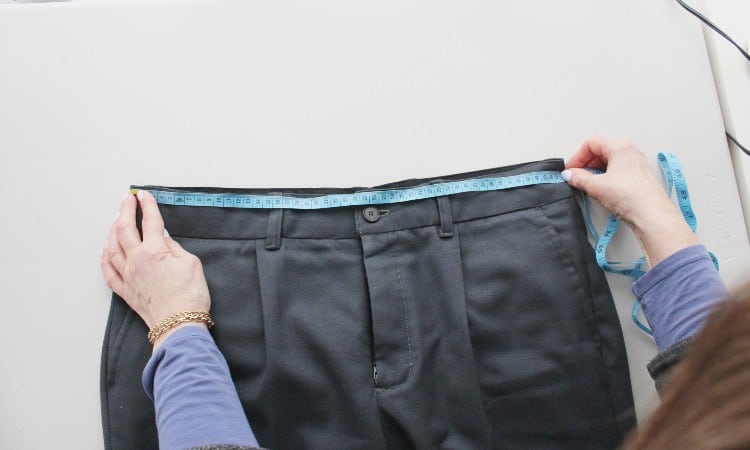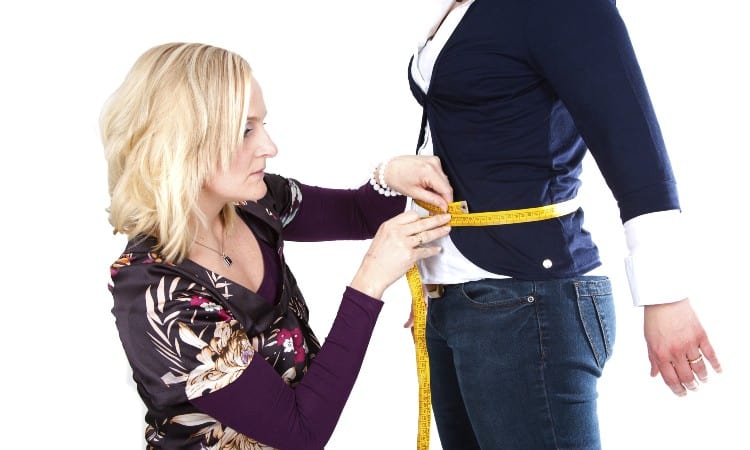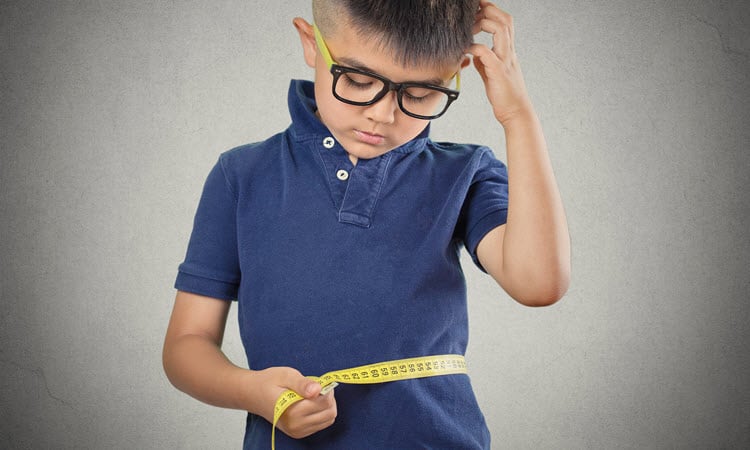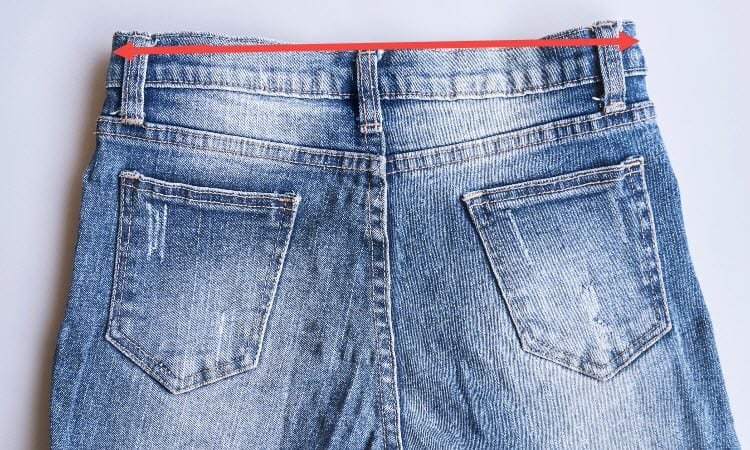How often have you ordered pants online in your size, only to find them too tight or much too baggy when you try them on? The fact is that American sizing has little consistency from one brand to another, which makes it hard to buy pants that fit unless you use measurements rather than sizes. If you learn how to measure the waist for pants, you can buy only pants that specifically match your own measurements!
One of the best ways to measure the waist for pants is to use a flexible tape measure around the torso at key points. Another popular method involves measuring the waistband on a pair of well-fitting pants and using those measurements as a reference point. Without a tape measure, a piece of knotted string can work as a temporary measurement.
In this article, you will find out how to take a waist measurement for men, women, and children. You will discover how pants sizing works. Finally, you will find tips to help you understand pant sizes, such as a 32-inch waist or a size XL.

Quick Navigation
What is a Waist Measurement For Pants?
The waist measurement for pants is the full length of the top edge of the waistband. To find this measurement on a pair of pants, you already own, simply lay the pants flat and use a tape measure to measure the front of the waistband, and then double that number.
This sounds quite simple. You would think that clothing manufacturers could put this measurement on the pants they sell, and you could just pick the precise measurement that fits your body. But this is not how things work!
You come up against three common issues when figuring out waist measurement for pants in American clothing brands. First, you face the problem of vanity sizing.
Whether you want to buy a women’s size L or a men’s size 32, the size or number means very little anymore. Manufacturers have learned that shoppers like to think that they fit into a “size 6” or a “34-inch waist” no matter what the shopper’s actual body type of waist measurement is!
You see this a lot in women’s pants and jeans that use numeric sizes like 6, 8, and 12 to describe the size of the garment. Still, even though men’s pants supposedly use inch measurements to describe the waist circumference, you will find some discrepancies here!
For this reason, many brands use generous sizing indicators that don’t reflect any accurate measurements at all. Instead, most brands provide something called a sizing chart online in the product description for a piece of clothing. You can learn more about using a sizing chart to find your perfect fit later in this article!
Second, you face the problem of size fluctuation from one brand to another. You may think that you wear size 8 jeans as a woman or 30-inch waist jeans as a man, but if you try on size 8 jeans from two different brands, each pair of jeans will fit you very differently!
This happens because there is no universally agreed-upon system to regulate sizes, so every brand can pretty much make up whatever sizing system it wants.
Finally, one of the biggest reasons people don’t understand pant waist measurements lies in the difference between the pants rise and waist circumference. You have to understand both of these measurements to find pants or jeans that fit you!
The actual waist measurement of pants or jeans is the circumference of the top edge of the waistband, as you already know. But here is the catch–the waistband on pants or jeans does not always rest at your natural waistline. Instead, it may sit at your hips, navel, or even far above your navel!
The height of the waistband is determined by a measurement called the rise. The front rise on a pair of pants measures the distance from the crotch seam to the center top of the waistband, and this tells you where the waistband will rest on your body. A hip-hugger waistband will have a much larger circumference than the waistband on a pair of high-rise jeans that snugs in at your actual waist!
For this reason, you can’t just measure yourself around the waist and then head to a store thinking that you simply need to find a pair of pants that matches that one measurement.
How To Measure Waist Size For Pants
Learning how to measure your waist size for pants will help you get pants that fit! You can use these measurements and a brand’s sizing chart to order clothing online or measure yourself before you go out shopping at a brick-and-mortar store, so you know what sizes to look for.
For Men

Men’s pants, trousers, and jeans use one of the more simple measurement systems. Most brands offer a variety of sizing points in the product description for each garment, including the waist size, the rise, the inseam, and the outseam of the pants.
The waist measurement almost always comes in terms of inches. This does not mean that you can just whip a tape measure around your waist and then buy pants that match that measurement, though! Most brands add either 1.5 or 2 full inches to the actual waistband. For instance, a brand will market pants with a “32-inch waist,” but the waist circumference will actually measure 34 inches!
Yes, it is ridiculous. But that’s vanity sizing for you! For this reason, you need to measure yourself accurately and then match your measurement to the numbers provided in the sizing chart, rather than going by the inches on the product itself.
To measure your own waist, take a flexible tape measure such as a sewing tape measure and hold one end in place just above your navel. Wrap the measure around your natural waist, keeping it level all the way around. This measurement tells you the circumference of your natural waist.
For Women

The numbers used to describe women’s pants sizes have almost nothing to do with any realistic measurements, so you will want to depend on your own accurate measurements to get well-fitting pants!
For women, you often need two different measurements: your waist measurement and your hip measurement. To measure your waist, use a soft tape measure to measure your natural waist. To do this, stand with your feet flat on the floor and place one end of the tape just above your navel. Keep the tape level, wrap it around your torso, and note the measurement.
To measure your hips, repeat this process, but start with the tape measure at the widest part of one hip bone, and then wrap it around the circle of your hips.
Compare the waist measurement to the sizing chart provided by the clothing manufacturer. In most cases, you can buy pants in the size that corresponds to your actual waist size, but you will also want to check the hip size.
If a size 6 from the brand matches your waist size but has a too-small hip size, the pants will not fit! This is a frequent problem in women’s pants because women tend to have curvier hips than men, and not every clothing brand will fit your body type.
For Children

Depending on the age of your child, children’s pant waist measurements can come in different formats. Baby clothing sizes usually begin with the age, such as 0 to 3 months. Sometimes manufacturers use a weight instead, such as 14 to 18 lbs.
Toddler clothes use the “T” system, such as 2T, 3T, etc., which often roughly correspond with two and three old body types. Boy and girl clothing for kids ages about six through thirteen typically uses an S, M, L metric, which can vary a lot in actual measurement from brand to brand.
And then, of course, teen clothing comes in Juniors sizes, which also vary a lot from brand to brand.
The one thing you can count on across all these different ways to size children’s pants is that you can usually match your child’s actual waist size to a sizing chart. To do this, wrap a tape measure around your child just above their hip bones. Then compare that measurement with the waist size listed in the sizing chart the clothing manufacturer almost always provides online.
If you have a little squirm bug who will not stand still for these measurements, you can also measure a pair of pants that fits your child well. To do this, lay the pair of pants flat on a floor or table. Smooth out the pants, but don’t stretch them out–often, waistbands have a natural curve or dip at the front.
Measure across the top edge of the waistband, and then flip the pants over and measure across the back. Add the two numbers together, and you have the waist measurement for your child’s pants!
Without a Tape
If you do not have access to a tape measure and you’re in a hurry to buy some new pants, you can try using a piece of string for a rough-and-ready measurement.
Hold one end of a piece of string just above your navel. Wrap the loose end of the string around your natural waistline, keeping it level. Do not pull tight, but don’t allow the string to sag.
Bring the loose end all the way around to meet the short end you’re holding above your navel. Tie a knot in the loose end to mark this point.
You can take this piece of string to a store with you to compare it to the pants you want to buy, or you can lie it flat against a yardstick or ruler to figure out a precise measurement!
For Pants, Suits, and Dresses
In general, using a tape measure around your natural waist will give you an accurate measurement for pants, whether they are dress pants, trousers, or suit pants. But you can also find some helpful tips for measuring the waist on pants, suits, and dresses:
- For men’s suit pants, the waistband usually lies at or just above the navel, at your natural waist. This makes measuring easy, but remember that you need to leave about a quarter-inch of extra room to tuck in your dress shirt.
- Formal wear pants, trousers, or suit pants for men usually only provide a waist size. They do not list a length size, as many manufacturers expect you to get these pants hemmed to your own height! The good news is that the waist measurement should be accurate, with no vanity sizing.
- For men and women, you will likely find that you need a different waist size in dress pants than you do for jeans or khakis.
- To measure the waist sizing on a dress, stand tall and bend to one side. Note where your body naturally creases, and then place a tape measure there at your natural waist. Wrap the tape around yourself, keeping it parallel to the floor but not too tight!
- Women’s dresses usually come in the small/medium/large sizing system, but you can find more precise waist, bust, and hip measurements listed in the sizing chart provided by most manufacturers.
For Jeans

You can find your waist size for jeans in a couple of different ways. Jean sizing gets a tad more complicated because denim shrinks so easily in the wash. For this reason, you may find it helpful to buy your jeans one size too big in case they shrink in the wash.
- For men, the simplest method is to find a pair of old jeans that fit you perfectly. Lay these jeans flat with the back of the jeans facing up. Measure across the top of the back of the waistband, and then double that measurement.
- For women, measure both your waist and hips, as you will want to match both of those measurements to get jeans that will fit across your lower body.
- Keep in mind that jeans come in many different rises, meaning that they can have a low, medium, or high waist. Every different waist height will have a different measurement.
- As always, referring to the sizing charts provided will give you the most accurate measurements.
What is My Size in Pants?
The best way to find your size in pants is to learn how to take your own measurements and then match your measurements to the sizing chart provided by clothing manufacturers.
Unfortunately, you will not find one perfect size in pants that you can always select! You will probably need to buy different sizes of pants from different brands to get a good fit.
To use a sizing chart, make sure you have your own measurements written down close at hand. Then orient yourself to the information provided in the chart. Most charts will offer body measurements on one side and the brand’s measurements on the other side. It will look roughly like this:
| Size S | Size M | Size L | |
| Waist (inches or cm) | 24 inches | 30 inches | 34 inches |
| Hip (inches or cm) | 34 inches | 40 inches | 40 inches |
| Bust (inches or cm) | 33 inches | 37 inches | 44 inches |
You then need to find the point where your measurements match the brand’s sizing! In some cases, you may find that one part of your body fits and another does not. For example, the waist measurement might fit your body, but the hip measurement could be too big or small. Unless you want to take your clothes to a tailor for alteration, you need to make sure all the measurements match up!
Waist Size vs Pant Size
Waist size and pant size may seem like the same thing, but they are actually a bit different! This is because clothing manufacturers usually add in an extra two inches beyond the “size” of the pant waist. If your jeans say they have a 32” waist, that actually means that the waistband on the jeans will measure about 34”.
The exception to this rule is many high-end dress pants, trousers, or suit pants. These often have more accurate pant sizes because they do not use vanity sizing.
If you read down far enough in the product description, you will usually find the actual waist size listed in a sizing chart. This will give an accurate measurement that you can match your own body by measuring around your torso with a flexible tape measure.
Popular Pants Sizes Explained
Now that you know how to find your own measurements, you may want to understand how popular pant sizes work.
Once again, men’s pants and jeans usually have sizing presented as two numbers. The first number is the waist size, though this is typically skewed by vanity sizing. The second number is the inseam measurement, from the crotch to the ankle on the inside of the leg.
Women’s pants sizes usually come in either a 0-16 sizing metric or in small, medium, large, and so on.
And of course, you should always check the sizing chart provided by the clothing manufacturer instead of just going by the size listed on the pants or jeans!
What Size is a 30-Inch Waist?
In general, you will find a 30-inch waist in a women’s size 8-10 or M if you go by US sizing metrics. For men, pants with a size of 30 will usually have a waist that actually measures 32 inches.
What Size is a 32-Inch Waist?
A 32-inch waist usually (though not always) means a size 10-14 or size L in women’s pants. For men, a 32-inch waist typically means an actual waist measurement of 34 inches.
What Size is a 34-Inch Waist?
A 34-inch waist usually means size 16 or XL for US women’s clothing. For men’s clothing, a 34-inch waist may actually mean a waistband circumference of up to 36 inches.
What Size is a 36-Inch Waist?
For women’s clothing in the United States, a 36-inch waist usually indicates pants in an Xl or XXL size. For men, a 36-inch waist usually has about 38” in the actual waistband.
How to Convert Waist Size to Jean Size
If the women’s sizing seemed confusing to you, this conversion chart will give you a handy reference for finding just the right jeans size for you!
| Waist in Inches | Women’s Jeans US Sizing | Women’s Jeans International Sizing |
| 24 | 0 | XXS |
| 26 | 2 | XS |
| 28 | 4-6 | S |
| 30 | 8-10 | M |
| 32 | 10-14 | L |
| 34 | 14-18 | XL |
| 36 | 18-22 | XXL |
Conclusion
Finding the right pair of pants or jeans gets a lot easier once you know how to measure your waist to find the right size! The best way to get pants or jeans that fit you just right is to take your own waist measurement and then compare that to the sizing chart provided by the clothing manufacturer.
You can easily take your measurement in two ways. First, you can stand straight, breathe out, and wrap a flexible tape measure around your torso just above your navel. Second, you can spread out a pair of jeans that fits you perfectly and measure the front and back of the waistband to find your waist measurement.